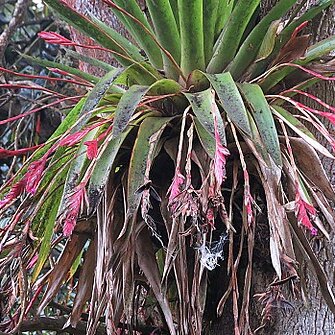Plant acaulescent, 12-25 cm tall, with a spreading rosette of many pale-green leaves, often purple-red streaked or spotted, with (many) inflorescences from the axils of the leaves. Leaves thin, chartaceous when dry, 16-35 cm long, shorter than to exceeding the spikes; sheaths ample, but not very distinct, evenly merging into the blades, elliptic, slightly inflated, (5.5-)8.5-15 x (2.5-)4.5-6 cm, brown punctulate-or minutely appressed-lepidote, concolorous pale-green, or in upper part dark purple-red; blade strongly arching, ligulate or narrowly triangular-ovate, 12-23 x 2.7-3.7 cm, attenuately acute, or obtuse and apiculate, subdensely and minutely appressed-lepidote outside, less so inside. Inflorescences axillary, simple, 15-40 cm long; scapes spreading upon the leaves, often decurved, 18-33 cm long, 1-2 mm in diam., glabrous, bracteate, but often partly visible, flat and prophyllate at the base; scape bracts erect, often remote, membranaceous, linear-lanceolate, the upper ones oblong, apiculate or acutish, mostly shorter than the internodes or slightly exceeding them, glabrous; spikes oblong to linear, more or less complanate, 3-12 x 0.8-1.2 cm, acute, densely and distichously 3-7(-14)-flowered, with a few sterile bracts at the base and apex; rachis hidden, flexuous, sharply angled (dry), glabrous; floral bracts erect, densely imbricate, thin-coriaceous, with even or veined (dry) surface, ovate, 1.4-2.2 cm long, 2-4 times als long as the internodes, much exceeding the sepals, obtuse, ecarinate, glabrous, green, rose to dark-purple. Flowers contiguous, sessile; sepals thin-coriaceous, oblong or lanceolate, 0.8-1.4 cm long, obtuse, posterior ones connate for about 2/3, carinate, strongly incurved at the apex, glabrous; petals linear-spathulate, to 2.5 cm long, the blade subspreading, oblong or lanceolate, rounded, rose, purple or blue; stamens all alike, somewhat shorter than the petals, exceeding the pistil by half of the anthers, filaments slender and flat, anthers basifixed, sagittate, ca. 4.5 mm long; ovary slenderly ovoid, evenly tapering, then constricted into the slender style, stigmas linear. Capsule cylindric (subprismatic), to 4 cm long, about twice as long as the bracts, attenuate, abruptly short-beaked.
More
Leaves many in a dense rosette, 3-4 dm. or rarely longer, mostly exceeding the inflorescences, spotted, streaked or suffused with dark purple especially toward base; sheaths elliptic or narrowly ovate, 10-16 cm. long, densely brown-appressed-lepidote; blades ligulate, abruptly acute or subobtuse, apiculate, 3-5 cm. wide, obscurely punctulate-lepidote, soon glabrous above. Scapes many from the axils of the leaves, ascending, 1-2 mm. thick above the flattened base, glabrous. Scape-bracts many, erect, usually imbricate, narrowly lanceolate, subchartaceous, nearly or quite glabrous. Inflorescences simple, lanceolate or linear,-acute, 4-to 24-flowered, to 8 cm. long, 15-20 mm. wide, usually com-planate, glabrous. Floral bracts imbricate, elliptic, obtuse, 15-25 mm. long, exceeding the sepals, ecarinate, coriaceous or subcoriaceous, even or nerved, often rose to purple. Flowers subsessils. Sepals lanceolate, acute, the posterior ones carinate and usually much connate. Petals about 2 cm. long, rose, purple or blue, the blade suberect. Stamens slightly shorter than the petals. Capsule slenderly cylindric, 4 cm. long.

